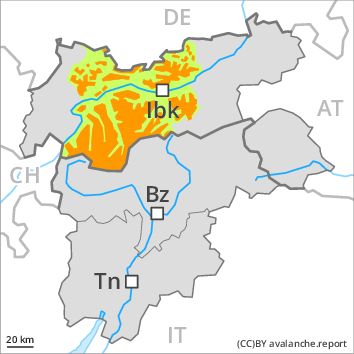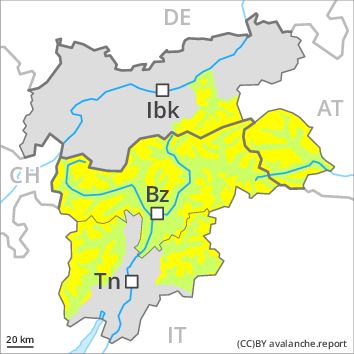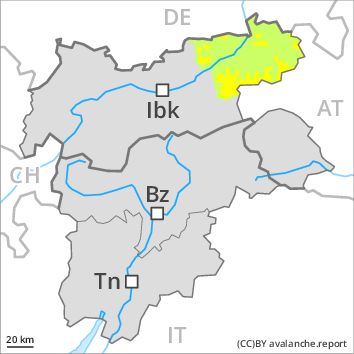Regions
Western Lechtal Alps, Central Lechtal Alps, Western Verwall Mountains, Eastern Verwall Mountains, Allgäu Alps, Silvretta, Samnaun Mountains

Danger level
Danger Level 3 - Considerable above the treeline
Danger Level 2 - Moderate above the treeline
Avalanche Problem
Wind-drifted snow above the treeline, N-NE-E-SE-S-SW-W-NW
Persistent weak layer above the treeline, E-SE-S-SW-W

Wind slabs and weakly bonded old snow require caution, in particular above the tree line.
As a consequence of fresh snow and a strong to storm force wind, sometimes easily released wind slabs will form in particular above the tree line. The avalanche prone locations are to be found adjacent to ridgelines and in gullies and bowls, and behind abrupt changes in the terrain. The wind slabs must be evaluated with care and prudence in all aspects. Avalanches can be released by a single winter sport participant and reach medium size.
Weak layers in the old snowpack can be released in particular on very steep sunny slopes, especially above the tree line. These avalanche prone locations are rather rare and are barely recognisable, even to the trained eye. In areas where the snow cover is rather shallow the avalanche prone locations are more prevalent.
As a consequence of the rain individual moist loose snow avalanches are possible below approximately 1500 m. Mostly these are small.
Snow sport activities outside marked and open pistes call for extensive experience in the assessment of avalanche danger and careful route selection.
Snowpack
dp 6: cold, loose snow and wind
dp 4: cold following warm / warm following cold
Over a wide area 20 to 30 cm of snow, and even more in some localities, has fallen since yesterday above approximately 1500 m. The wind will be strong to storm force. The fresh and older wind slabs are lying on soft layers in particular on shady slopes at intermediate and high altitudes. Faceted weak layers exist in the top section of the old snowpack on steep sunny slopes, in particular above the tree line. As a consequence of fresh snow and stormy weather the wind slabs will increase in size additionally. The snowpack will be moist at low altitude.
Tendency
The avalanche danger will persist.
Regions
Western Tuxer Alps, Karwendel Mountains, Glockturm Range, Grieskogel Mountains, Weißkugel Range, Gurgler Range, Central Stubai Alps, Eastern Lechtal Alps - Ammergau Alps, Northern Oetz and Stubai Alps, Mieming Mountains

Danger level
Danger Level 3 - Considerable above the treeline
Danger Level 1 - Low above the treeline
Avalanche Problem
Wind-drifted snow above the treeline, N-NE-E-SE-S-SW-W-NW
Persistent weak layer above the treeline, E-SE-S-SW-W

Wind slabs are to be evaluated critically. Weakly bonded old snow requires caution. This applies in particular above the tree line.
As a consequence of fresh snow and a strong to storm force wind, sometimes easily released wind slabs will form in particular above the tree line. The avalanche prone locations are to be found adjacent to ridgelines and in gullies and bowls, and behind abrupt changes in the terrain. These will increase with altitude. The wind slabs must be evaluated with care and prudence in all aspects. Avalanches can be released by a single winter sport participant and reach medium size.
Weak layers in the old snowpack can be released in particular on very steep sunny slopes, especially especially above the tree line. These avalanche prone locations are rather rare and are barely recognisable, even to the trained eye. In areas where the snow cover is rather shallow the avalanche prone locations are more prevalent.
Snow sport activities outside marked and open pistes call for extensive experience in the assessment of avalanche danger and careful route selection.
Snowpack
dp 6: cold, loose snow and wind
dp 4: cold following warm / warm following cold
Over a wide area 5 to 15 cm of snow, and even more in some localities, has fallen in the last few days above approximately 1500 m. 5 to 10 cm of snow. will fall until midday. The wind will be strong to storm force. The fresh and older wind slabs are lying on soft layers in particular on shady slopes at intermediate and high altitudes. Faceted weak layers exist in the top section of the old snowpack on steep sunny slopes, in particular above the tree line. As a consequence of fresh snow and stormy weather the wind slabs will increase in size additionally. The snowpack will be moist at low altitude.
Tendency
Fresh wind slabs represent the main danger.
Regions
Sexten Dolomites, Latemar, Val Müstair Alps, Langtaufers, Schnals Ridge, Southern Stubai Alps, Southern Zillertal Alps and High Tauern, Saldurn-Mastaun Ridge, Texel Mountains, Southern Adamello, Eastern Tuxer Alps, Sarntal Alps, Adamello - Presanella, Western Pfunderer Mountains, Northern Brenta - Peller, Southern Brenta, Southern Lagorai, Northern Lagorai, Maddalene, Eastern Pfunderer Mountains, Durreck Range, Western Rieserferner Mountains, Western Deferegger Alps, Ortler Range, Northern Zillertal Alps, Ulten Valley, Venediger Range, Eastern Nonsberger Alps, Eastern Rieserferner Mountains, Northern Dolomites of Fiemme, Glockner Range, Gröden Dolomites, Primiero - Pale di S. Martino, Eastern Deferegger Alps, Prags Dolomites, Schober Mountains, Lienzer Dolomites, Fassa Valley, Sole, Pejo and Rabbi

Danger level
Danger Level 2 - Moderate above the treeline
Danger Level 1 - Low above the treeline
Avalanche Problem
Wind-drifted snow above the treeline, N-NE-E-SE-S-SW-W-NW

Wind slabs are to be evaluated critically.
As a consequence of a strong to storm force wind, sometimes easily released wind slabs will form in particular above the tree line. The avalanche prone locations are to be found adjacent to ridgelines and in gullies and bowls, and behind abrupt changes in the terrain. The wind slabs must be evaluated with care and prudence in particular on steep shady slopes. The number and size of avalanche prone locations will increase with altitude. Snow sport activities outside marked and open pistes call for experience in the assessment of avalanche danger.
Snowpack
dp 6: cold, loose snow and wind
5 to 10 cm of snow. has fallen since yesterday above approximately 1500 m. Over a wide area up to 10 cm of snow, and even more in some localities, will fall. The wind will be strong to storm force. The fresh and older wind slabs are lying on soft layers in particular on shady slopes at intermediate and high altitudes. They are bonding poorly with the old snowpack above the tree line.
Tendency
The avalanche danger will persist.
Regions
Brandenberg Alps, Western Kitzbühel Alps, Wilder Kaiser Mountains - Waidring Alps, Eastern Kitzbühel Alps

Danger level
Danger Level 2 - Moderate above the treeline
Danger Level 1 - Low above the treeline
Avalanche Problem
Wind-drifted snow above the treeline, N-NE-E-SE-S-SW-W-NW

Fresh wind slabs represent the main danger.
As a consequence of fresh snow and a strong to storm force wind, sometimes easily released wind slabs will form in particular above the tree line. The avalanche prone locations are to be found adjacent to ridgelines and in gullies and bowls, and behind abrupt changes in the terrain. Avalanches can be released by a single winter sport participant, but they will be small in most cases.
Snowpack
dp 6: cold, loose snow and wind
Over a wide area 5 to 10 cm of snow. has fallen since yesterday above approximately 1500 m. The wind will be strong to storm force. The fresh and older wind slabs are lying on soft layers in particular on shady slopes at intermediate and high altitudes. As a consequence of fresh snow and stormy weather the wind slabs will increase in size additionally. Thus far only a little snow is lying.
Tendency
The avalanche danger will persist.




